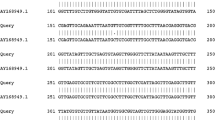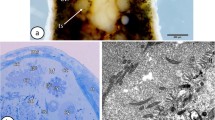Abstract
The fine structure of spermiogenesis and spermatozoa in three species of the Macrostomorpha was studied, with emphasis on Bradynectes sterreri. Two centrioles appear during the development of sperm cells, at least in B. sterreri and Paromalostomum fusculum. Initially these organelles have a perpendicular position, but later they come to lie in line with each other. In P. fusculum, the differentiation of rootlet structures inserting on both centrioles was found. However, ciliary axonemes do not grow out, either in B. sterreri or in P. fusculum. These two species, and also Haplopharynx rostratus, have aciliated spermatozoa. The mature male gametes of B. sterreri are characterized by a filiform nucleus, numerous mitochondria, dense bodies irregular in shape, membranous lacunae, a pair of electron-dense lateral ledges and two sets of cortical microtubules in addition to a closed ring of microtubules in the posterior segment of the cell. Both lateral ledges do not originate from the centrioles. ’Lateral ledges’ or ’lateral bristles’ were not observed in spermatozoa of H. rostratus and P. fusculum. Such structures cannot be considered autapomorphic for the Macrostomorpha. The known spermatological characteristics contribute to elucidating the interrelationships of the Macrostomorpha. Haplopharynx and Macrostomida are sister groups. Spermatozoa with cortical microtubules separated into two sets are hypothesized as an autapomorphy of the Macrostomida. The two lateral ledges found in spermatozoa of B. sterreri are discussed to correspond to the pair of ’lateral bristles’ known from Macrostomum species, indicating a sister-group relationship of these two taxa. Apparently, the aciliated spermatozoa of Macrostomorpha species originated from biciliated male gametes. Hence, biciliated spermatozoa are not an evolutionary novelty of the Trepaxonemata, but of the Rhabditophora.
Similar content being viewed by others
Author information
Authors and Affiliations
Additional information
Accepted: 22 February 1999
Rights and permissions
About this article
Cite this article
Sopott-Ehlers, B., Ehlers, U. Ultrastructure of spermiogenesis and spermatozoa in Bradynectes sterreri and remarks on sperm cells in Haplopharynx rostratus and Paromalostomum fusculum: phylogenetic implications for the Macrostomorpha (Plathelminthes). Zoomorphology 119, 105–115 (1999). https://doi.org/10.1007/s004350050085
Issue Date:
DOI: https://doi.org/10.1007/s004350050085




